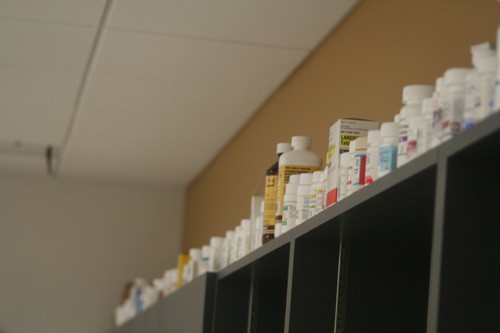Arizona’s pharmacies may need a heavy dose of assistance to correct their flawed software.
Of the 64 different pharmacies examined by the UA College of Pharmacy, 72 percent had “”failing”” computerized decision support systems. The software, which alerts pharmacists to potentially dangerous drug interactions, was put to the test in pharmacies all across Arizona. Testing sites included correctional facilities, inpatient hospitals and chain stores. And the results did not come as a surprise to some. Decision support software malfunctions have always existed and will probably never go away, said Terri Warholak, a pharmacy assistant professor who took part in the study.
More than 20,000 different drug products stock U.S. pharmacy shelves, Warholak said. The exponential nature of drug interactions makes it impossible to pin and identify all of them, especially those that may be harmful or fatal.
This is especially true when a patient is on many different medications, which Warholak said is not uncommon.
System analysis consisted of inserting the information of a fictitious patient into the software of the 64 pharmacies. Contained in the set of prescriptions were 18 different medications arranged to render 13 serious drug interactions. In the study, only 18 of the tested software systems picked them all out correctly.
“”This issue isn’t a kind of black and white,”” said Daniel Malone, a pharmacy professor who also took part in the study. “”It really is lots of shades of gray.””
Most of the software correctly identified the majority of the budding hazards but the decision system only had to miss one potential problem to constitute “”failure,”” Malone said.
The study is in the process of a follow-up to gauge changes the 64 pharmacies implemented into their systems, if any.
“”We (initially) really didn’t think that any of the developers would take us seriously,”” Warholak said. “”Since then, several of the companies have contacted us voluntarily to ask for assistance and to assess their systems. I’m very hopeful that we’ll have a positive change.””
Malone added that a mechanical oversight does not necessarily mean the pharmacist would miss the problem as well. The probability of a pharmacist recognizing what the software can’t is measured on a case-by-case basis, he said.
Many of the software systems are customized by and to a specific pharmacy and carry countless differences and caveats, even within the same pharmaceutical chain. However, only a handful of companies actually manufacture the original and untampered software that most pharmacies use, meaning the problem is not limited to Arizona, Warholak said.
UA researchers understand the problem’s severity and are working diligently to improve the nation’s health care system, Warholak said.
“”A lot of times people say ‘Oh, people in academia live in ivory towers. They don’t do anything practical or useful,'”” she said. “”Well, we’re trying very hard to influence positive change that will have an impact on every one of us.””
She added that approaching the problem from a software-systemic standpoint, instead of an individual or personal perspective, would yield the greatest results and improvements.
And although it may not seem like it at first glance, Warholak said there is a lot that patients and customers can do to help their pharmacist and, more importantly, themselves.
Going to the same pharmacy, developing a personal relationship and having an open pathway of communication between patient and pharmacist greatly increases the quality of treatment and results in a reduction of errors. Doing so will change you from “”just another number”” to a person, Warholak said.









